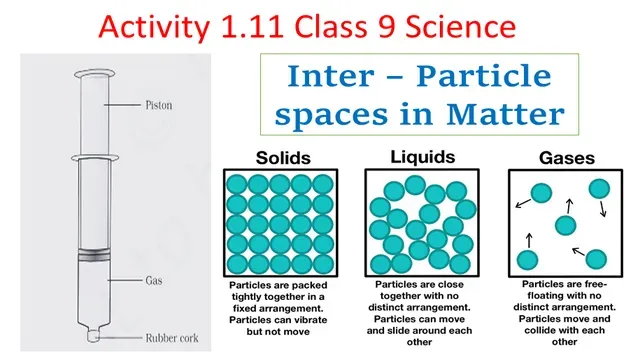In this post, you will find NCERT Science Class 9 Chapter 1 Activity solutions. In Class 9 science chapter 1 matter in our surroundings consists NCERT Activity 1.11 Class 9 Science Explanation with conclusion.
NCERT Activity 1.11 Class 9 Science Explanation with conclusion
You are suggested to study
NCERT activity 1.11 class 9 science explanation with conclusion so that you can
attempt questions based on the activity 1.11 class 9 science.
 |
| Explain Activity 1.11 Science Class 9 Matter in Our Surroundings |
Activity 1.11 Class 9 Science
· Take three 100 ml syringes and close their nizzles by rubber corks, as shown in figure
· Remove the pistons from all the syringes.
· Leaving one syringe untouched, fill water in the second and pieces of chalk in the third.
· Insert the pistons back into the syringes. You may apply some Vaseline to the pistons before inserting them into the syringes for their smooth movement.
· Now try to compress the content by pushing the piston in each syringe.
· What do you observe? In which case was the piston easily pushed in?
· What do you infer from the observation?
Observation of Activity 1.11 Class 9 Science
The first syringe which was left untouched contained air. this syringe
was easily pushed in. the piston of the second syringe which contains water has
been pushed only a little while the piston of the third syringe filled with chalk pieces
could not be pushed in.
Explanation of Activity 1.11 Class 9 Science
Solid, liquid, and gas are the main three states of matter. All matter is
composed of small particles. These particles are bounded by the force of
attraction. The Force of attraction between particles of solids, liquids, and gases is
different.
The compressibility of any substance depends upon inter-particle spaces. The gases
have the largest inter particles spaces while liquids have lesser and the solids
have the least inter-particle spaces.
Conclusion of Activity 1.11 Class 9 Science
Gases are highly compressible while liquids are incompressible and
solids are completely incompressible.
Querries based on activity 1.11 Class 9 Science
1. Give the order of compressibility of matter.
Ans. Solids >Liquids> Gases
2. Give the order of interparticle spaces between particles of matter.
Ans Gases >Liquids >solids
Related Topics
1. Next Activity- Activity 1.12 Class 9 Science
2. Previous Activity - Activity 1.10 Class 9 Science



